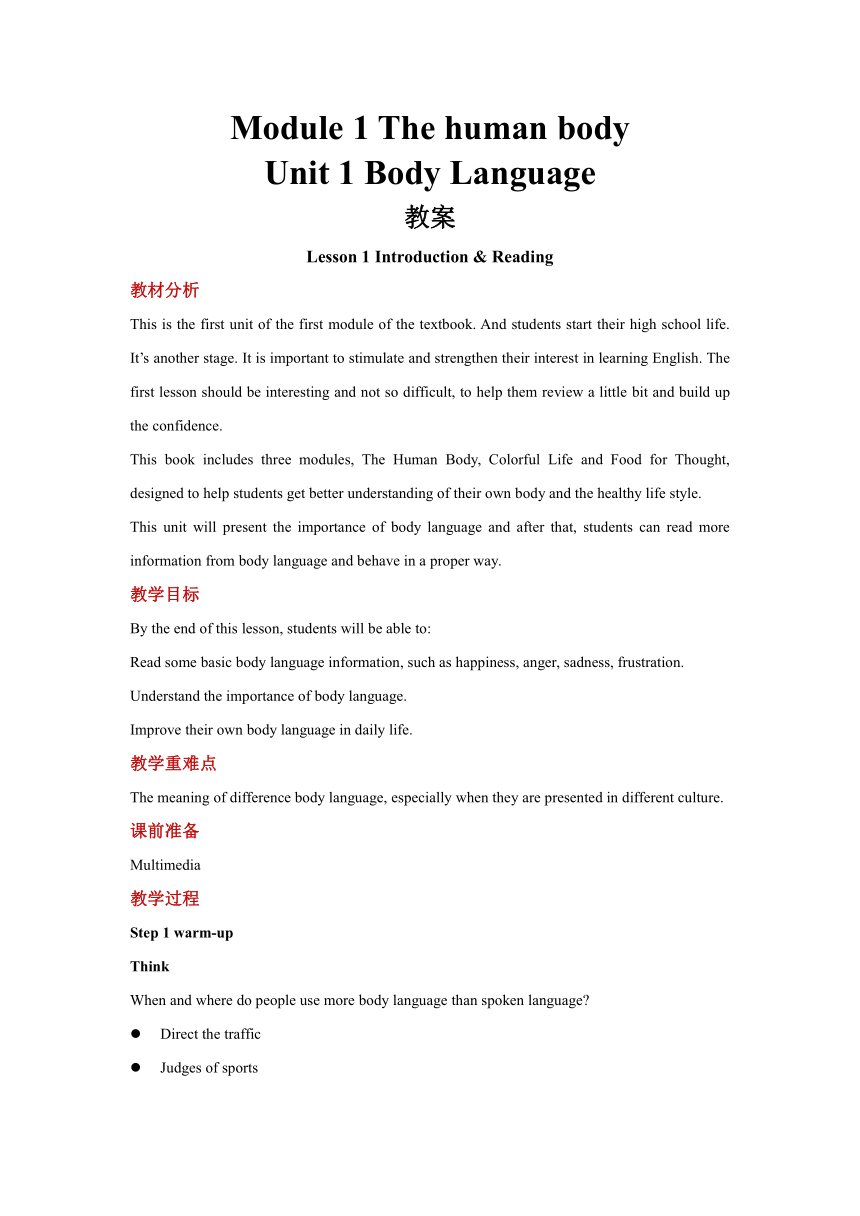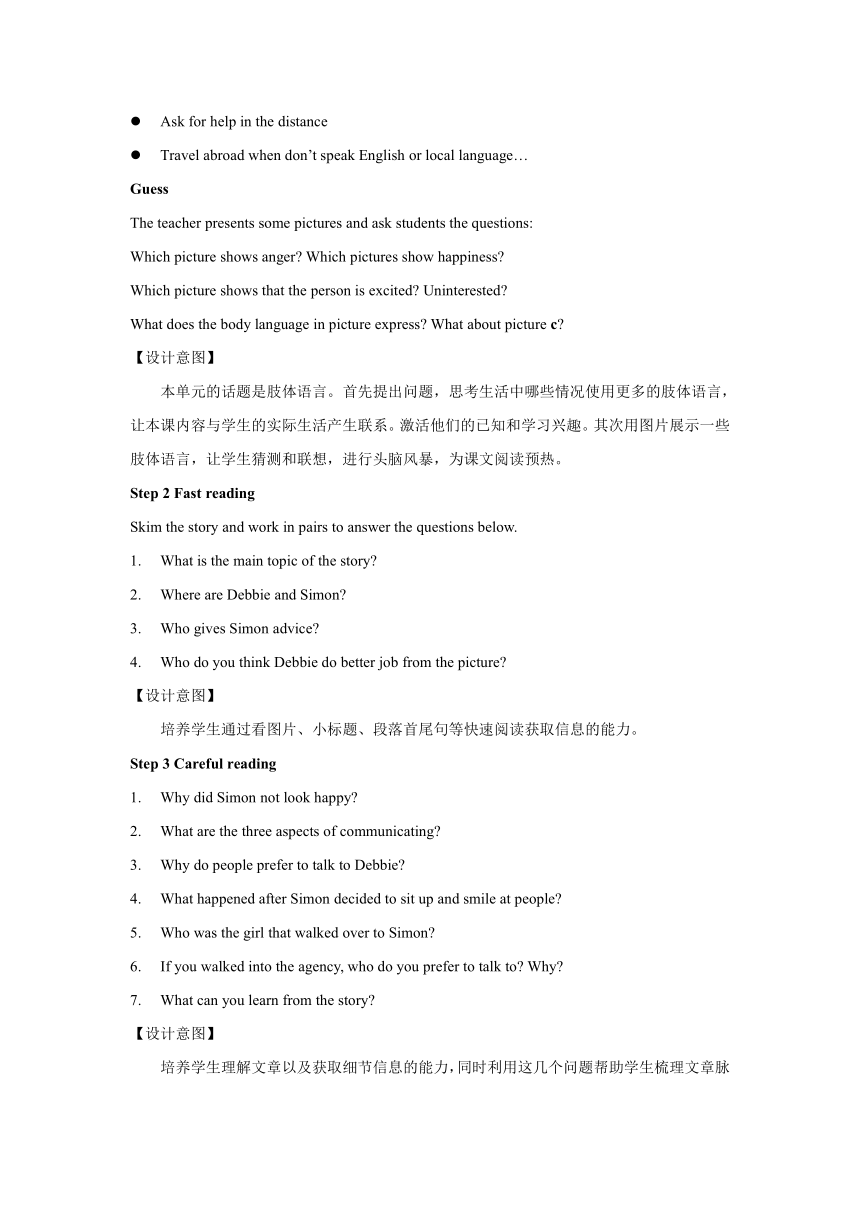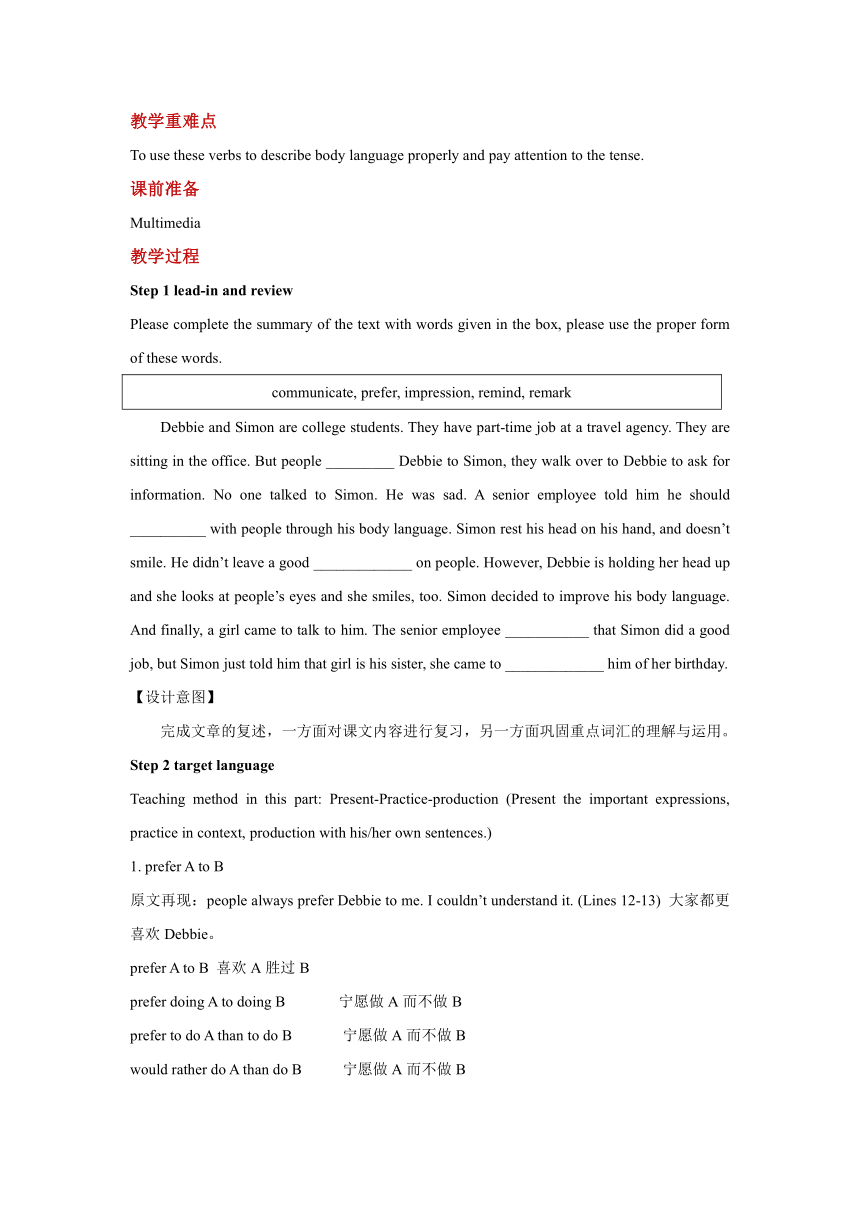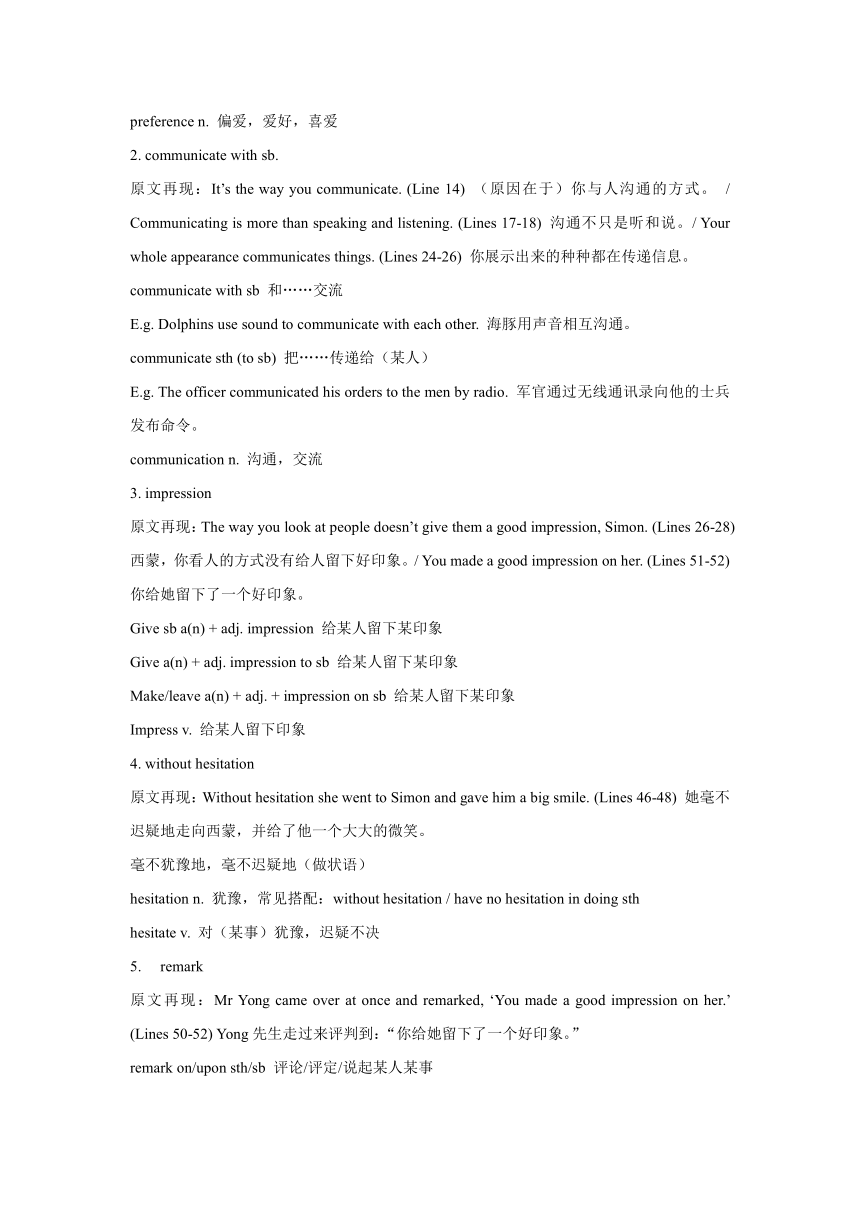Module 1 The human body Unit 1 Body Language同步教案
文档属性
| 名称 | Module 1 The human body Unit 1 Body Language同步教案 |

|
|
| 格式 | zip | ||
| 文件大小 | 26.3KB | ||
| 资源类型 | 教案 | ||
| 版本资源 | 牛津上海版(试用本) | ||
| 科目 | 英语 | ||
| 更新时间 | 2019-07-29 23:03:30 | ||
图片预览





文档简介
Module 1 The human body
Unit 1 Body Language
教案
Lesson 1 Introduction & Reading
教材分析
This is the first unit of the first module of the textbook. And students start their high school life. It’s another stage. It is important to stimulate and strengthen their interest in learning English. The first lesson should be interesting and not so difficult, to help them review a little bit and build up the confidence.
This book includes three modules, The Human Body, Colorful Life and Food for Thought, designed to help students get better understanding of their own body and the healthy life style.
This unit will present the importance of body language and after that, students can read more information from body language and behave in a proper way.
教学目标
By the end of this lesson, students will be able to:
Read some basic body language information, such as happiness, anger, sadness, frustration.
Understand the importance of body language.
Improve their own body language in daily life.
教学重难点
The meaning of difference body language, especially when they are presented in different culture.
课前准备
Multimedia
教学过程
Step 1 warm-up
Think
When and where do people use more body language than spoken language?
Direct the traffic
Judges of sports
Ask for help in the distance
Travel abroad when don’t speak English or local language…
Guess
The teacher presents some pictures and ask students the questions:
Which picture shows anger? Which pictures show happiness?
Which picture shows that the person is excited? Uninterested?
What does the body language in picture express? What about picture c?
【设计意图】
本单元的话题是肢体语言。首先提出问题,思考生活中哪些情况使用更多的肢体语言,让本课内容与学生的实际生活产生联系。激活他们的已知和学习兴趣。其次用图片展示一些肢体语言,让学生猜测和联想,进行头脑风暴,为课文阅读预热。
Step 2 Fast reading
Skim the story and work in pairs to answer the questions below.
What is the main topic of the story?
Where are Debbie and Simon?
Who gives Simon advice?
Who do you think Debbie do better job from the picture?
【设计意图】
培养学生通过看图片、小标题、段落首尾句等快速阅读获取信息的能力。
Step 3 Careful reading
Why did Simon not look happy?
What are the three aspects of communicating?
Why do people prefer to talk to Debbie?
What happened after Simon decided to sit up and smile at people?
Who was the girl that walked over to Simon?
If you walked into the agency, who do you prefer to talk to? Why?
What can you learn from the story?
【设计意图】
培养学生理解文章以及获取细节信息的能力,同时利用这几个问题帮助学生梳理文章脉络。引导学生进行学习反思。
Step 4 Read and Think
Put the events of the story in the correct order by writing 1 to 8 in the blanks.
Mr Young said that body language is important. _____
The lady walked over to Debbie instead of Simon. _____
Simon began to sit up and smile. _____
A well-dressed lady entered the travel agency. _____
Mr Young said that Debbie made others feel welcome. _____
Simon’s sister reminded him of her birthday. _____
Simon walked over to the fax machine. _____
Mr Young said that Simon looked downwards. _____
【设计意图】
上述八件小事涉及文章的细节逻辑,训练学生的逻辑思维能力以及对文章的理解程度。
Step 5 Homework
Conclude the good body language used by Debbie. And add 2 kinds of body language to help improve their service in the travel agency.
【设计意图】
通过阅读和理解这篇文章,学生认识到好的肢体语言非常重要,那么,从Debbie身上有哪些值得学习的肢体语言呢?通过总结和反思巩固本文所学内容。
Lesson 2 Language Points
教材分析
This passage focuses on the different body language between Simon and Debbie. There are many verb phrases to describe the differences.
教学目标
By the end of this lesson, students will be able to:
(1) Use the target words or phrases properly: prefer, communicate, impression, remark, remind, A be more than B, without hesitation.
(2) Review and be aware of the usage of different tenses. Simple present, present continuous, simple future, simple past, present perfect, past continuous, past perfect.
教学重难点
To use these verbs to describe body language properly and pay attention to the tense.
课前准备
Multimedia
教学过程
Step 1 lead-in and review
Please complete the summary of the text with words given in the box, please use the proper form of these words.
communicate, prefer, impression, remind, remark
Debbie and Simon are college students. They have part-time job at a travel agency. They are sitting in the office. But people _________ Debbie to Simon, they walk over to Debbie to ask for information. No one talked to Simon. He was sad. A senior employee told him he should __________ with people through his body language. Simon rest his head on his hand, and doesn’t smile. He didn’t leave a good _____________ on people. However, Debbie is holding her head up and she looks at people’s eyes and she smiles, too. Simon decided to improve his body language. And finally, a girl came to talk to him. The senior employee ___________ that Simon did a good job, but Simon just told him that girl is his sister, she came to _____________ him of her birthday.
【设计意图】
完成文章的复述,一方面对课文内容进行复习,另一方面巩固重点词汇的理解与运用。
Step 2 target language
Teaching method in this part: Present-Practice-production (Present the important expressions, practice in context, production with his/her own sentences.)
1. prefer A to B
原文再现:people always prefer Debbie to me. I couldn’t understand it. (Lines 12-13) 大家都更喜欢Debbie。
prefer A to B 喜欢A胜过B
prefer doing A to doing B 宁愿做A而不做B
prefer to do A than to do B 宁愿做A而不做B
would rather do A than do B 宁愿做A而不做B
preference n. 偏爱,爱好,喜爱
2. communicate with sb.
原文再现:It’s the way you communicate. (Line 14) (原因在于)你与人沟通的方式。 / Communicating is more than speaking and listening. (Lines 17-18) 沟通不只是听和说。/ Your whole appearance communicates things. (Lines 24-26) 你展示出来的种种都在传递信息。
communicate with sb 和……交流
E.g. Dolphins use sound to communicate with each other. 海豚用声音相互沟通。
communicate sth (to sb) 把……传递给(某人)
E.g. The officer communicated his orders to the men by radio. 军官通过无线通讯录向他的士兵发布命令。
communication n. 沟通,交流
3. impression
原文再现:The way you look at people doesn’t give them a good impression, Simon. (Lines 26-28) 西蒙,你看人的方式没有给人留下好印象。/ You made a good impression on her. (Lines 51-52) 你给她留下了一个好印象。
Give sb a(n) + adj. impression 给某人留下某印象
Give a(n) + adj. impression to sb 给某人留下某印象
Make/leave a(n) + adj. + impression on sb 给某人留下某印象
Impress v. 给某人留下印象
4. without hesitation
原文再现:Without hesitation she went to Simon and gave him a big smile. (Lines 46-48) 她毫不迟疑地走向西蒙,并给了他一个大大的微笑。
毫不犹豫地,毫不迟疑地(做状语)
hesitation n. 犹豫,常见搭配:without hesitation / have no hesitation in doing sth
hesitate v. 对(某事)犹豫,迟疑不决
remark
原文再现:Mr Yong came over at once and remarked, ‘You made a good impression on her.’ (Lines 50-52) Yong先生走过来评判到:“你给她留下了一个好印象。”
remark on/upon sth/sb 评论/评定/说起某人某事
remind
原文再现:She wanted to remind me that tomorrow is her birthday. (Lines 53-55) 她是我妹妹,她来提醒我明天是她的生日。
remind sb of/about sth 提醒某人某事;使某人想起
remind sb to do sth 提醒某人去做某事
A be more than B
原文再现:Communicating is more than speaking and listening. (Lines 17-18) 沟通不只是听和说。
more than 超出,不仅仅
more than + adj. 非常
【设计意图】
讲解重点词汇,把握词根进行适当的拓展。在语境中学习词语。
Step 3 different tenses
Teachers use PPT to present some pictures to create context to show different tenses. And Students should try to figure out and conclude what tenses have been presented.
Examples:
You often rest your head on your hand.
She is holding her head up.
It will be sunny tomorrow.
He sat up and smiled at people.
People have communicated with body language.
Was the sun shining at that time?
After I had finished the book. I switched off the light.
Tenses included: simple present, present continuous, simple future, simple past, present perfect, past continuous, past perfect.
【设计意图】
教师呈现例句,让学生尽快回顾各种基本时态。
Try to figure the differences among tenses through practice.
Practice 1
I read stories in my spare time.
I am reading a story now.
-Have you moved into the new house?
-Not yet. The rooms are being painted.
Practice 2
He served in the army from 1952 to 1954.
He has served in the army for 5 years.
I saw Hero last year.
I have seen Hero before.
Practice 3
He joined the army 3 years ago.
He has been in the army for 3 years.
It is 3 years since he joined the army.
Practice 4
He studied there two years ago.
He said he had studied two years before.
Helen had left her keys in the office so she had to wait until her husband came home.
I had hoped to meet Tom this evening, but I found nobody left in the room.
By then he had learnt English for 3 years.
【设计意图】
通过同一个句子与不同时间词搭配时辨析动词时态的选用。
Step 4 consolidation
Please finish the exercise on your textbook on page6, page7 and page8.
【设计意图】
在不同场景下选用合适时态的动词,在语篇中练习和巩固。
Lesson 3 Listening and Speaking
教材分析
Skills for this unit focuses on identifying descriptive words and try to use these words to describe people.
教学目标
By the end of this class, students are able to:
Identify descriptive words in a dialogue
Describing people
教学重难点
Identify different kinds of descriptive words.
课前准备
PPT, multimedia
教学流程
step 1 listen and complete the notes below
Ballet history
It is a (1)___________ form of art.
The movements are very (2)____________ and (3)____________.
Ballet can tell stories and express (4)_________ moods.
This kind of (5)____________ dance started 400 years ago in (6)__________ Europe.
It became a (7)______________ show on its own in the (8)____________ century.
It has become a (9)____________ means of entertainment in many places round the world.
Through television, (10)___________ people can watch two of the (11)__________ ballets, Swan Lake and Sleeping Beauty.
Conclusion
descriptive words are usually adjective, and they often follow
articles: a, an, the
linking verbs: be, seem, get, become, etc.
possessives: my, your, his, her, our, etc
【设计意图】
从一篇文章入手,让学生自己从文中总结出描述性词汇的特征,并学会归纳和总结。
Step 2 speaking
When do we need to describe a person?
When we want to introduce a new friend.
When the police want to find out more evidence.
Before we have a blind date.
Etc.
What do we usually talk about when we describe what someone looks like?
Age: a teenager, about sixteen, twenty-five years old
Height: tall average height, short
Weight: thin average weight, heavy
Hair: short, black, medium-length, blond, long, brown
Eye color: blue eyes, brown eyes, dark eyes.
Dressing: in a red dress, a pair of black pants, a large coat
Personality: always smile, happy, a little blue
Practice 1
What would you like to describe the teacher?
Practice 2
Guess game: students are divided into two groups, each time, one student is going to describe one of the classmates, the rest students in two groups need to guess who he/she is describing, the faster group which guess out the specific person will win the game. If the group win one round, the win one point. This can last for several rounds.
【设计意图】
先给学生搭好支架,让他们了解描述一个人的几个方面,再从身边熟悉的老师和同学入手,开始练习。第二个活动既增加了课堂的趣味性,竞争的形式也激发了同学开口表达的热情。
Lesson 4 Writing
教材分析
This unit focuses on writing short messages such as reminders, notes and invitations.
教学目标
By the end of this class, students are able to:
Understand why and when we write short messages;
Write a short message in correct form.
教学重难点
The form of a short message
课前准备
PPT, multimedia
教学流程
Step 1 understand why and when we write short messages
Think about what should you write under theses situation:
You are going to have a birthday party. You need to invite your friends.
You miss your friends in New York, so you decide to visit her in this summer, you are going to tell her your plan.
You are the head student in Student Union. The school is holding a photography competition soon, you need to announce everyone about this.
Your mom is sleeping, you want to go out with your friends and you won’t come back for dinner, you need to tell her about where are you going and what you are going to do.
【设计意图】
联系生活中的实际场景,激活学生的已知储备,让学生了解到本节课的写作学习非常实用,激发学习兴趣。
Step 2 how to write a short message
There are six parts: greeting, the date, the message, signature, the topic, the closing.
Example:
Dear Ji Weihong 10 September
I want to remind you about our tennis game tomorrow afternoon.
I will meet you outside the club at 2:00 p.m.
Remember to bring your tennis shoes.
Regards
Simon
Practice: page11
【设计意图】
通过一个例子展示短文写作的格式。再通过一个练习加强巩固。
Homework
Try to choose one from the above situations (1)-(4) to write a short message. Pay attention to the form of your writing.
【设计意图】
巩固所学知识,回到实际运用中。
Unit 1 Body Language
教案
Lesson 1 Introduction & Reading
教材分析
This is the first unit of the first module of the textbook. And students start their high school life. It’s another stage. It is important to stimulate and strengthen their interest in learning English. The first lesson should be interesting and not so difficult, to help them review a little bit and build up the confidence.
This book includes three modules, The Human Body, Colorful Life and Food for Thought, designed to help students get better understanding of their own body and the healthy life style.
This unit will present the importance of body language and after that, students can read more information from body language and behave in a proper way.
教学目标
By the end of this lesson, students will be able to:
Read some basic body language information, such as happiness, anger, sadness, frustration.
Understand the importance of body language.
Improve their own body language in daily life.
教学重难点
The meaning of difference body language, especially when they are presented in different culture.
课前准备
Multimedia
教学过程
Step 1 warm-up
Think
When and where do people use more body language than spoken language?
Direct the traffic
Judges of sports
Ask for help in the distance
Travel abroad when don’t speak English or local language…
Guess
The teacher presents some pictures and ask students the questions:
Which picture shows anger? Which pictures show happiness?
Which picture shows that the person is excited? Uninterested?
What does the body language in picture express? What about picture c?
【设计意图】
本单元的话题是肢体语言。首先提出问题,思考生活中哪些情况使用更多的肢体语言,让本课内容与学生的实际生活产生联系。激活他们的已知和学习兴趣。其次用图片展示一些肢体语言,让学生猜测和联想,进行头脑风暴,为课文阅读预热。
Step 2 Fast reading
Skim the story and work in pairs to answer the questions below.
What is the main topic of the story?
Where are Debbie and Simon?
Who gives Simon advice?
Who do you think Debbie do better job from the picture?
【设计意图】
培养学生通过看图片、小标题、段落首尾句等快速阅读获取信息的能力。
Step 3 Careful reading
Why did Simon not look happy?
What are the three aspects of communicating?
Why do people prefer to talk to Debbie?
What happened after Simon decided to sit up and smile at people?
Who was the girl that walked over to Simon?
If you walked into the agency, who do you prefer to talk to? Why?
What can you learn from the story?
【设计意图】
培养学生理解文章以及获取细节信息的能力,同时利用这几个问题帮助学生梳理文章脉络。引导学生进行学习反思。
Step 4 Read and Think
Put the events of the story in the correct order by writing 1 to 8 in the blanks.
Mr Young said that body language is important. _____
The lady walked over to Debbie instead of Simon. _____
Simon began to sit up and smile. _____
A well-dressed lady entered the travel agency. _____
Mr Young said that Debbie made others feel welcome. _____
Simon’s sister reminded him of her birthday. _____
Simon walked over to the fax machine. _____
Mr Young said that Simon looked downwards. _____
【设计意图】
上述八件小事涉及文章的细节逻辑,训练学生的逻辑思维能力以及对文章的理解程度。
Step 5 Homework
Conclude the good body language used by Debbie. And add 2 kinds of body language to help improve their service in the travel agency.
【设计意图】
通过阅读和理解这篇文章,学生认识到好的肢体语言非常重要,那么,从Debbie身上有哪些值得学习的肢体语言呢?通过总结和反思巩固本文所学内容。
Lesson 2 Language Points
教材分析
This passage focuses on the different body language between Simon and Debbie. There are many verb phrases to describe the differences.
教学目标
By the end of this lesson, students will be able to:
(1) Use the target words or phrases properly: prefer, communicate, impression, remark, remind, A be more than B, without hesitation.
(2) Review and be aware of the usage of different tenses. Simple present, present continuous, simple future, simple past, present perfect, past continuous, past perfect.
教学重难点
To use these verbs to describe body language properly and pay attention to the tense.
课前准备
Multimedia
教学过程
Step 1 lead-in and review
Please complete the summary of the text with words given in the box, please use the proper form of these words.
communicate, prefer, impression, remind, remark
Debbie and Simon are college students. They have part-time job at a travel agency. They are sitting in the office. But people _________ Debbie to Simon, they walk over to Debbie to ask for information. No one talked to Simon. He was sad. A senior employee told him he should __________ with people through his body language. Simon rest his head on his hand, and doesn’t smile. He didn’t leave a good _____________ on people. However, Debbie is holding her head up and she looks at people’s eyes and she smiles, too. Simon decided to improve his body language. And finally, a girl came to talk to him. The senior employee ___________ that Simon did a good job, but Simon just told him that girl is his sister, she came to _____________ him of her birthday.
【设计意图】
完成文章的复述,一方面对课文内容进行复习,另一方面巩固重点词汇的理解与运用。
Step 2 target language
Teaching method in this part: Present-Practice-production (Present the important expressions, practice in context, production with his/her own sentences.)
1. prefer A to B
原文再现:people always prefer Debbie to me. I couldn’t understand it. (Lines 12-13) 大家都更喜欢Debbie。
prefer A to B 喜欢A胜过B
prefer doing A to doing B 宁愿做A而不做B
prefer to do A than to do B 宁愿做A而不做B
would rather do A than do B 宁愿做A而不做B
preference n. 偏爱,爱好,喜爱
2. communicate with sb.
原文再现:It’s the way you communicate. (Line 14) (原因在于)你与人沟通的方式。 / Communicating is more than speaking and listening. (Lines 17-18) 沟通不只是听和说。/ Your whole appearance communicates things. (Lines 24-26) 你展示出来的种种都在传递信息。
communicate with sb 和……交流
E.g. Dolphins use sound to communicate with each other. 海豚用声音相互沟通。
communicate sth (to sb) 把……传递给(某人)
E.g. The officer communicated his orders to the men by radio. 军官通过无线通讯录向他的士兵发布命令。
communication n. 沟通,交流
3. impression
原文再现:The way you look at people doesn’t give them a good impression, Simon. (Lines 26-28) 西蒙,你看人的方式没有给人留下好印象。/ You made a good impression on her. (Lines 51-52) 你给她留下了一个好印象。
Give sb a(n) + adj. impression 给某人留下某印象
Give a(n) + adj. impression to sb 给某人留下某印象
Make/leave a(n) + adj. + impression on sb 给某人留下某印象
Impress v. 给某人留下印象
4. without hesitation
原文再现:Without hesitation she went to Simon and gave him a big smile. (Lines 46-48) 她毫不迟疑地走向西蒙,并给了他一个大大的微笑。
毫不犹豫地,毫不迟疑地(做状语)
hesitation n. 犹豫,常见搭配:without hesitation / have no hesitation in doing sth
hesitate v. 对(某事)犹豫,迟疑不决
remark
原文再现:Mr Yong came over at once and remarked, ‘You made a good impression on her.’ (Lines 50-52) Yong先生走过来评判到:“你给她留下了一个好印象。”
remark on/upon sth/sb 评论/评定/说起某人某事
remind
原文再现:She wanted to remind me that tomorrow is her birthday. (Lines 53-55) 她是我妹妹,她来提醒我明天是她的生日。
remind sb of/about sth 提醒某人某事;使某人想起
remind sb to do sth 提醒某人去做某事
A be more than B
原文再现:Communicating is more than speaking and listening. (Lines 17-18) 沟通不只是听和说。
more than 超出,不仅仅
more than + adj. 非常
【设计意图】
讲解重点词汇,把握词根进行适当的拓展。在语境中学习词语。
Step 3 different tenses
Teachers use PPT to present some pictures to create context to show different tenses. And Students should try to figure out and conclude what tenses have been presented.
Examples:
You often rest your head on your hand.
She is holding her head up.
It will be sunny tomorrow.
He sat up and smiled at people.
People have communicated with body language.
Was the sun shining at that time?
After I had finished the book. I switched off the light.
Tenses included: simple present, present continuous, simple future, simple past, present perfect, past continuous, past perfect.
【设计意图】
教师呈现例句,让学生尽快回顾各种基本时态。
Try to figure the differences among tenses through practice.
Practice 1
I read stories in my spare time.
I am reading a story now.
-Have you moved into the new house?
-Not yet. The rooms are being painted.
Practice 2
He served in the army from 1952 to 1954.
He has served in the army for 5 years.
I saw Hero last year.
I have seen Hero before.
Practice 3
He joined the army 3 years ago.
He has been in the army for 3 years.
It is 3 years since he joined the army.
Practice 4
He studied there two years ago.
He said he had studied two years before.
Helen had left her keys in the office so she had to wait until her husband came home.
I had hoped to meet Tom this evening, but I found nobody left in the room.
By then he had learnt English for 3 years.
【设计意图】
通过同一个句子与不同时间词搭配时辨析动词时态的选用。
Step 4 consolidation
Please finish the exercise on your textbook on page6, page7 and page8.
【设计意图】
在不同场景下选用合适时态的动词,在语篇中练习和巩固。
Lesson 3 Listening and Speaking
教材分析
Skills for this unit focuses on identifying descriptive words and try to use these words to describe people.
教学目标
By the end of this class, students are able to:
Identify descriptive words in a dialogue
Describing people
教学重难点
Identify different kinds of descriptive words.
课前准备
PPT, multimedia
教学流程
step 1 listen and complete the notes below
Ballet history
It is a (1)___________ form of art.
The movements are very (2)____________ and (3)____________.
Ballet can tell stories and express (4)_________ moods.
This kind of (5)____________ dance started 400 years ago in (6)__________ Europe.
It became a (7)______________ show on its own in the (8)____________ century.
It has become a (9)____________ means of entertainment in many places round the world.
Through television, (10)___________ people can watch two of the (11)__________ ballets, Swan Lake and Sleeping Beauty.
Conclusion
descriptive words are usually adjective, and they often follow
articles: a, an, the
linking verbs: be, seem, get, become, etc.
possessives: my, your, his, her, our, etc
【设计意图】
从一篇文章入手,让学生自己从文中总结出描述性词汇的特征,并学会归纳和总结。
Step 2 speaking
When do we need to describe a person?
When we want to introduce a new friend.
When the police want to find out more evidence.
Before we have a blind date.
Etc.
What do we usually talk about when we describe what someone looks like?
Age: a teenager, about sixteen, twenty-five years old
Height: tall average height, short
Weight: thin average weight, heavy
Hair: short, black, medium-length, blond, long, brown
Eye color: blue eyes, brown eyes, dark eyes.
Dressing: in a red dress, a pair of black pants, a large coat
Personality: always smile, happy, a little blue
Practice 1
What would you like to describe the teacher?
Practice 2
Guess game: students are divided into two groups, each time, one student is going to describe one of the classmates, the rest students in two groups need to guess who he/she is describing, the faster group which guess out the specific person will win the game. If the group win one round, the win one point. This can last for several rounds.
【设计意图】
先给学生搭好支架,让他们了解描述一个人的几个方面,再从身边熟悉的老师和同学入手,开始练习。第二个活动既增加了课堂的趣味性,竞争的形式也激发了同学开口表达的热情。
Lesson 4 Writing
教材分析
This unit focuses on writing short messages such as reminders, notes and invitations.
教学目标
By the end of this class, students are able to:
Understand why and when we write short messages;
Write a short message in correct form.
教学重难点
The form of a short message
课前准备
PPT, multimedia
教学流程
Step 1 understand why and when we write short messages
Think about what should you write under theses situation:
You are going to have a birthday party. You need to invite your friends.
You miss your friends in New York, so you decide to visit her in this summer, you are going to tell her your plan.
You are the head student in Student Union. The school is holding a photography competition soon, you need to announce everyone about this.
Your mom is sleeping, you want to go out with your friends and you won’t come back for dinner, you need to tell her about where are you going and what you are going to do.
【设计意图】
联系生活中的实际场景,激活学生的已知储备,让学生了解到本节课的写作学习非常实用,激发学习兴趣。
Step 2 how to write a short message
There are six parts: greeting, the date, the message, signature, the topic, the closing.
Example:
Dear Ji Weihong 10 September
I want to remind you about our tennis game tomorrow afternoon.
I will meet you outside the club at 2:00 p.m.
Remember to bring your tennis shoes.
Regards
Simon
Practice: page11
【设计意图】
通过一个例子展示短文写作的格式。再通过一个练习加强巩固。
Homework
Try to choose one from the above situations (1)-(4) to write a short message. Pay attention to the form of your writing.
【设计意图】
巩固所学知识,回到实际运用中。
